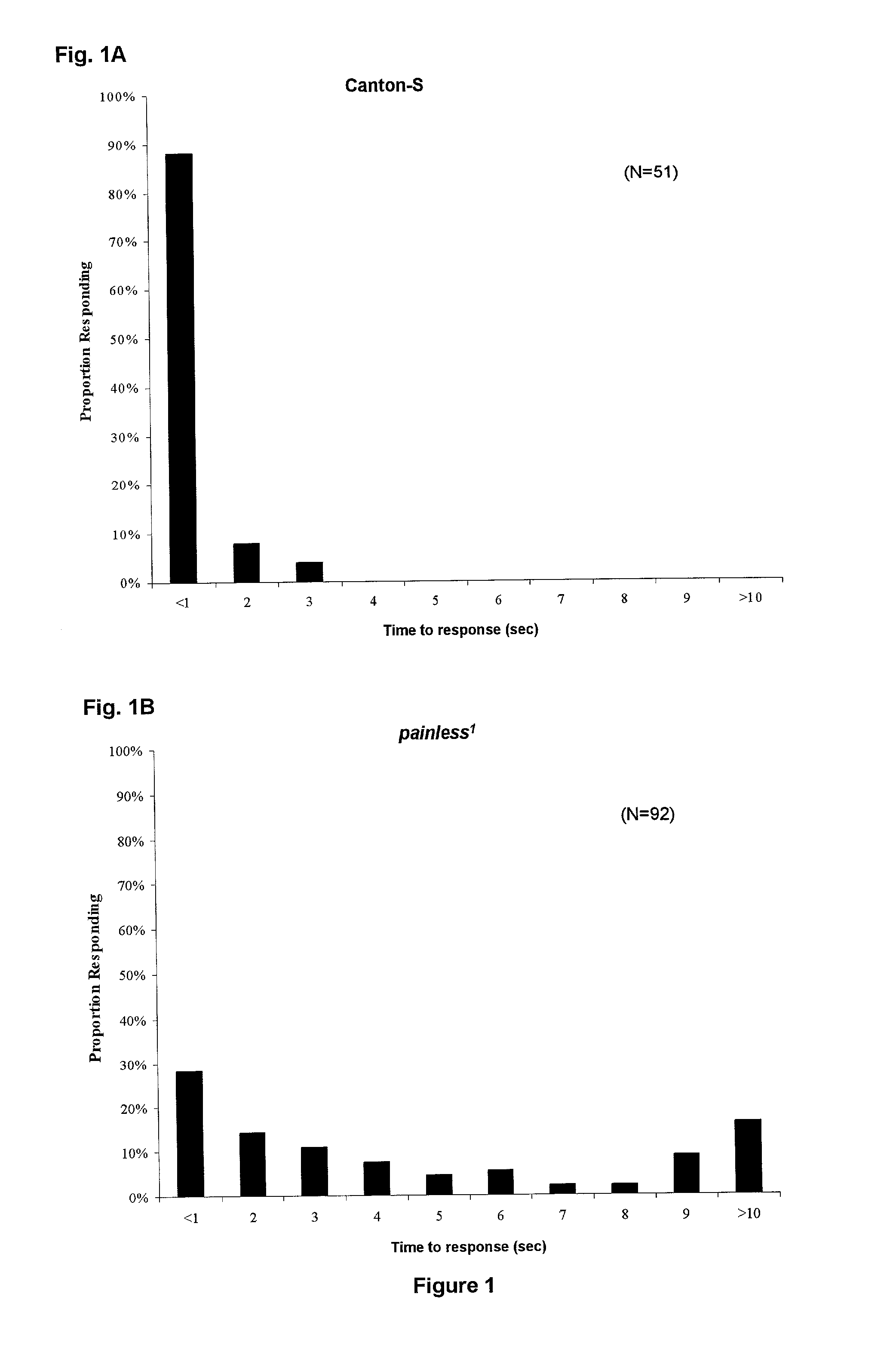Methods and compositions associated with nociceptive pain
- Summary
- Abstract
- Description
- Claims
- Application Information
AI Technical Summary
Benefits of technology
Problems solved by technology
Method used
Image
Examples
example 1
Forward Genetic Analysis Of Nociception
[0170]To identify genes important for nociception, a genetic screen for mutations that cause sensitivity to noxious heat was performed. A collection of fly lines that carry P-elements randomly inserted within the genome (Rorth et al (1998) Development 125, 1049–57) was screened. The advantage of screening this particular collection of P-element insertions is that most of the lines have had their insertion site precisely determined by the Berkeley Drosophila Genome Project (BDGP). In addition, the P-elements used to generate these lines, called EP elements, contain gal4 binding upstream activation sequences (UAS) on their 3′ end. Thus, EP elements inserted in the proper orientation can be used to drive tissue-specific expression of the gene downstream of the insertion site when the cell line containing the identified P-element is crossed to a gal4 driver expressing line (Rorth, et al., 1998, supra).
[0171]Third instar larvae homozygous for insert...
example 2
Painless Encodes a Putative Ion Channel
[0173]To determine the precise location of the EP(2)2451 insertion, the genomic DNA flanking the EP-element was cloned and sequenced by plasmid rescue. The nucleic acid sequence obtained for the flanking region is the same as the sequence previously determined for this insertion by the Berkeley Drosophila Genome Project. The insertion is located 3.6 kilobases upstream of the predicted gene CG15860 (painless) (SEQ ID NO:1; predicted amino acid sequence is the sequence set forth in SEQ ID NO:2 (Accession Number AAF47293; FIG. 5)). Using the predicted amino acid sequence of CG15860 to probe the protein databases with BLAST, the closest protein relatives of known function were found to be ion channels of the transient receptor potential (TRP) / vanilloid receptor family. Consistent with this, the predicted painless protein contains ankryin repeats at its N-terminus and a TRP like ion channel domain near its C-terminus.
[0174]Interestingly, the vanillo...
example 3
Neuronal Circuitry Essential to Nociception
[0182]In vertebrates, the cell bodies of nociceptors are located in sensory ganglia, such as the dorsal root ganglia. These cells have projections to the periphery where profuse branching of naked dendrites occurs beneath the skin. In contrast to other sensory modalities (i.e. thermal receptors and touch receptors) which utilize specialized receptor cells to transduce signals, the naked dendrites of nociceptors themselves are thought to contain transducing machinery for noxious stimuli. Similar distinctions prevail in the peripheral nervous system of Drosophila. Type I sensory neurons, e.g., chordotolnal neurons and mechanoreceptors, have a single dendrite as part of a specialized sensillum such as a hair (Hartenstein (1988). Development 102, 869–886). Type II or multi-dendritic (md) sensory neurons, do not appear to be associated with a specialized receptor cell but utilize naked dendrites. Others are assoicated with muscles, contain a sim...
PUM
 Login to View More
Login to View More Abstract
Description
Claims
Application Information
 Login to View More
Login to View More - R&D Engineer
- R&D Manager
- IP Professional
- Industry Leading Data Capabilities
- Powerful AI technology
- Patent DNA Extraction
Browse by: Latest US Patents, China's latest patents, Technical Efficacy Thesaurus, Application Domain, Technology Topic, Popular Technical Reports.
© 2024 PatSnap. All rights reserved.Legal|Privacy policy|Modern Slavery Act Transparency Statement|Sitemap|About US| Contact US: help@patsnap.com










